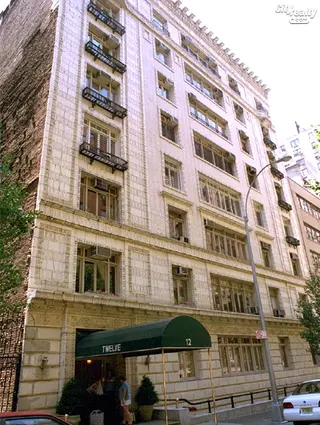 Carter Horsley
Carter HorsleyDec 23, 2011
Carter's Review
This very distinguished, 8-story, mid-block apartment building is one of the most attractive glazed terracotta structures in the city.
Its entire façade is covered in bright white glazed terracotta, which gives it a gleam never matched by the multitude of "white-brick" apartment towers that began to spread across the city in the 1950s and 1960s.
The building is almost symmetrical. The central section of the building has a very wide window flanked by two smaller windows and the east end of the street frontage has a medium-wide window and the west end a small window. The windows at the west and east ends are framed in continuous pilasters with decorative borders. All the windows are deeply inset giving the façade a very strong sense of depth and drama. Furthermore, all the windows are multipaned with quite large panes comprising the lower four-fifths and many small panes across the top one-fifth that reinforce the building's horizontal accents, which include four bandcourses and a large cornice. The end windows have short wrought-iron balcony railings on the third through the seventh floors. Those on the top floor have angled balconies that continue the decorative relief of the large bandcourse at that level.
The first story of the building has a rusticated treatment and a low fence for its dry moat and lanterns flank its entrance.
The overall effect of the façade, then, is extremely lively. It is surprising that such an elegant treatment was not more widely copied as it is a superb composition that combines the classicism of many Italian Renaissance-palazzo-style approaches with a "clean" modernism.
It was designed by George and Edward Blum, who were the architects of several very interesting buildings on the Upper West Side that combine Beaux-Arts traditions and Art Nouveau and Arts & Crafts touches.
The building was originally called The Capitol and was designed with only one, five-bedroom apartment a floor. During construction, the building collapsed, killing four workers.
During the Depression, some of the units were subdivided and when rent-control laws were introduced in 1943, more were subdivided "for which market rents could be charged," observed Andrew Alpern in his excellent book, "Historic Manhattan Apartment Houses" (Dover Publications, Inc., 1996), that devotes an entire chapter to this building. One of the illustrations shows the building with its original large cornice, which is now missing, although its many bracket supports remain and give the building a rather interesting top when viewed from the street.
The original Venetian Renaissance-style lobby was replaced in the 1940's with mirrors, light-colored wood and zebra-stripped upholstery, according to Mr. Alpern. In the late 1990s, however, the lobby was redone in a bright, light-colored, modern lobby much more in keeping with the building's architecture.
The building's west side is adjacent to a very pleasant garden that belongs to Liederkranz Hall, a club that was formerly a Phipps family mansion designed by Grosvenor Atterbury. The northeast corner of 87th Street and Fifth Avenue had been the site of a very large and impressive mansion with gardens behind a balustraded limestone fence that had also belonged to the Phipps family and was eventually replaced by the handsome apartment building at 1060 Fifth Avenue.
This is a very quiet block in the heart of the Carnegie Hill neighborhood, which is named after Andrew Carnegie, the steel magnate, who was also a partner with Henry Phipps. Carnegie's mansion still stands, with its large fenced garden, on Fifth Avenue between 90th and 91st Streets.
A supermarket is nearby on Madison Avenue, which also has numerous nice boutiques and restaurants. There is excellent cross-town bus service on 86th Street and many important cultural institutions and many leading private schools in the vicinity.
The building has no garage, no health club and no sidewalk landscaping. It has a part-time doorman and permits protruding air-conditioners. It was converted to a cooperative in 1985 and has 28 apartments.
Carter B. Horsley

- Co-op built in 1910
- 2 apartments currently for sale ($739K to $1.295M)
- Located in Carnegie Hill
- 31 total apartments 31 total apartments
- 10 recent sales ($510K to $3.2M)
- Doorman
- Pets Allowed
 6sqft delivers the latest on real estate, architecture, and design, straight from New York City.
6sqft delivers the latest on real estate, architecture, and design, straight from New York City.
